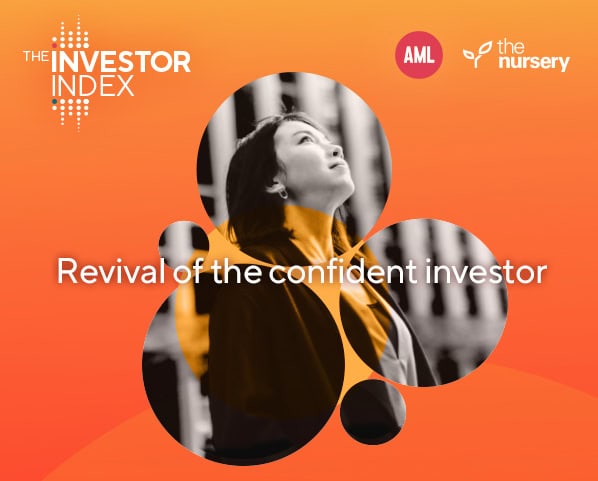AML x The Nursery
Investor Index 2025
The Investor Index, conducted alongside The Nursery, is our annual study measuring investor sentiment and behaviour. Now, in its sixth iteration, the Index tracks how confidence has been rewired in the face of increased market volatility and an unpredictable geopolitical picture.
Last year saw a record high level of confidence in investors, with US equities, particularly in the technology sector, performing strongly, and optimism about upcoming elections. This year, however, investors have had to face reality; trade wars, disruption, and volatility have defined the markets in the 12 months since the previous report. However, over the past 6 years we have seen the emergence of a generation of investor who have come to the fore alongside almost constant crisis. They are rewired to tune out market noise and take a more measured approach to investing.
Confidence holds firm amidst chaos as new investors step up
Investor confidence has held steady in 2025 – just below last year’s high of 105 and well above the post-pandemic lows. And notably, this stability held firm even as the survey landed during the height of the tariffs crisis – a period of increased market tension. This resilience reflects a new investor mindset – led by younger investors and separately, increasingly visible among women, who are showing rising confidence and engagement despite heightened disruption and volatility. They’re not waiting for stability; they’re investing through uncertainty. In contrast, older investors have adopted more of a wait-and-see stance since 2024, with many viewing Trump’s return as a potential threat to market stability – softening the overall uplift. Yet across the board, one theme cuts through: 67% say long-term investing is more important than ever. In 2025, investor confidence is shaped less by markets – and more by mindset.
Self-reliant but not alone: the rise of supported investing
47% of investors are putting more money to work in 2025, both through financial advisors and DIY platforms. As this activity grows, so do expectations around support: services need to be easy to understand, quick to access, and backed by brands they trust. While self-research still dominates, many are supplementing it with expert input – turning to financial advisors and digital platforms that support, rather than replace, their thinking. Robo-advisors have regained momentum, and 33% of investors are now using AI tools like ChatGPT for financial guidance and information. As trust shifts toward more structured, accessible sources, investors are becoming more selective with informal voices – with the influence of friends and family declining, and finfluencers followed but not trusted. Investor independence remains central, but it’s increasingly underpinned by smarter, more deliberate choices in how they stay informed.
Political impact is clear – but perspectives are divided
The UK and US elections have been a moment of reckoning for investors – with nearly 70% saying the outcome of each election has had a tangible impact on their portfolios. But when taken together, the effect is almost universal: 99% of investors say their portfolios were influenced by at least one of the two. Beneath that shared exposure, however, lies a clear divide in how those effects are felt. Men are more likely than women to say the US election shaped their outlook, while younger investors tend to see political change as a positive force across both markets. Older investors are more circumspect, particularly in the UK, where new tax reforms have raised fresh concerns. The result is a picture of contrast: the same events, interpreted through different expectations – of government, of markets, and of the future.
Intenders are open – but still holding back
Intenders – those with the savings but not yet the confidence to invest – remain a high-potential group still sitting on the sidelines. They’re held back by a strong aversion to risk and fear of loss, driven by a lack of faith in the market’s ability to bounce back and uncertainty about where or how to begin. But they’re not disengaged. Many are open to both digital and traditional guidance, with 78% having paid or would be open to paying for financial advice and showing a clear appetite for learning. What they need isn’t motivation, but clarity: simpler products, lower fees, and more accessible pathways to getting started.
Summary
Despite feeling less in control, investor confidence is here to stay, driven by the younger audiences who are sensing considerable opportunity amidst recent market volatility. What facilitates this is a more considered and intentional approach to investing, with long-termism prevailing, and formal sources quieting the more hype-driven assets.
Intenders, on the other hand, see the current situation as too risky, their loss aversion keeping them from entering the market. They, unlike investors, have not developed the agnosticism to wider market forces. Crucially, what is needed to turn intenders into investors is education; of where and how to start, and of low-risk options that appease their appetite and reframe what risk means to them.


